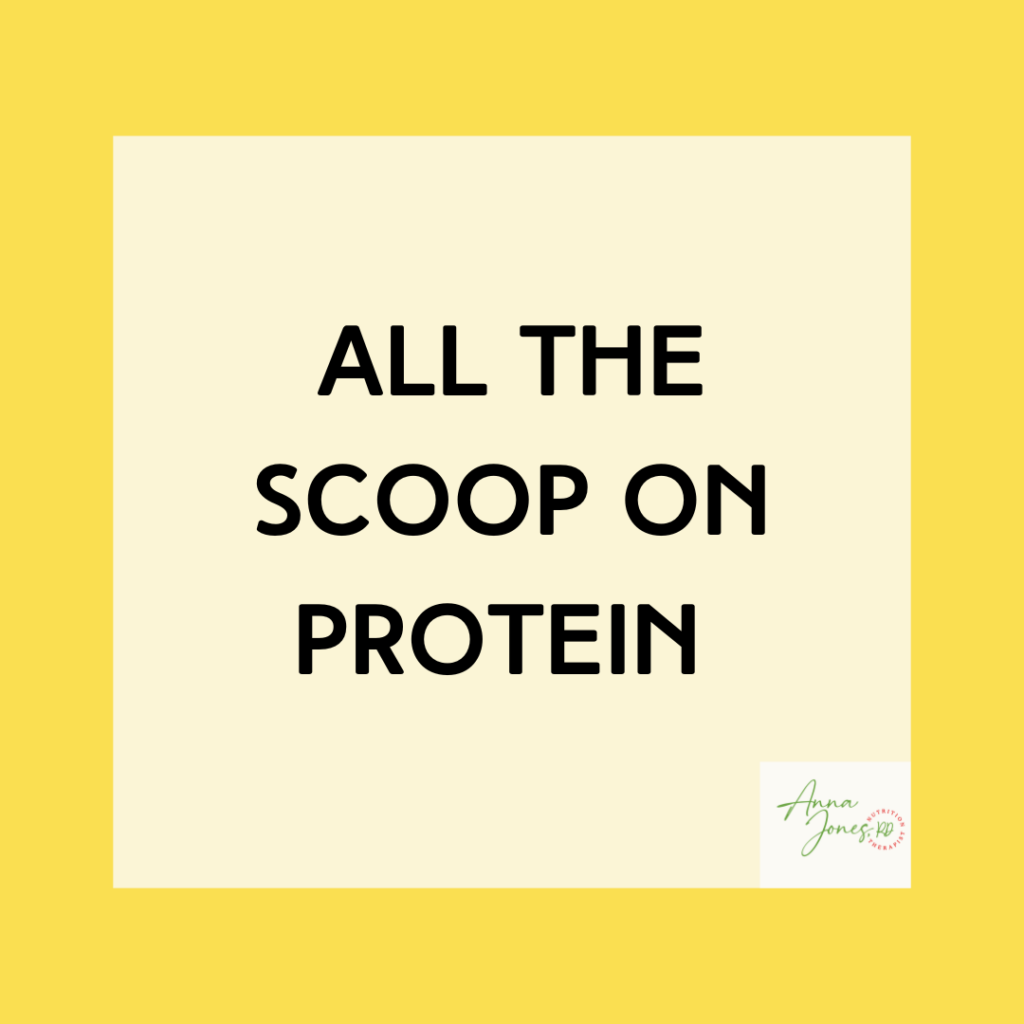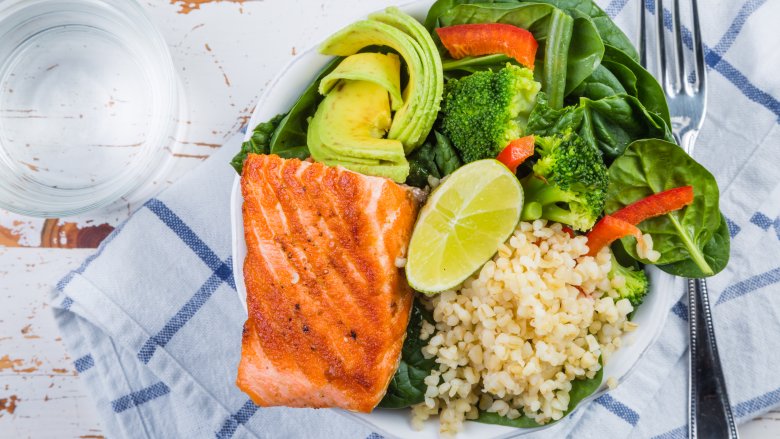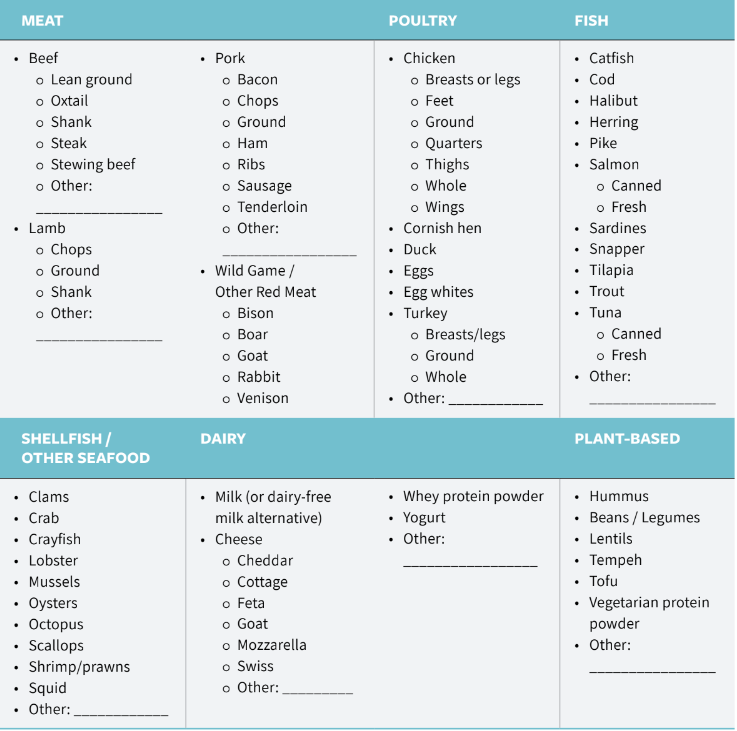
Protein, now more than ever, seems to be having a moment. I walked in the grocery store the other day and was bombarded by packages touting added PROTEIN, cottage cheese is everywhere on social media, and there seems to be an uptick in clients interested in counting their “macros” and “getting enough protein.”
It seems to be the darling of nutrients right now and everywhere I turn some person or product is screaming protein, protein, protein! No wonder it is on so many of our minds and we feel like we need more. This is really the way of the wellness and non-evidence-based nutrition world, if something is good then more has to be great. But this very often isn’t the case.
While protein is important, all through the life span, and particularly as we age, myths and misinformation around this macronutrient are all too common. Keep reading to learn all the facts including why protein is important, the best sources, and how much we really need according to current evidence.
What is protein and why is it important?
Protein is one of three macronutrients: protein, carbohydrate, and fat. Macronutrients are the main sources of energy that food provides. The protein we eat is digested and broken down into amino acids, which are building blocks for many processes of the body. Protein has many functions including:
- Providing energy and supporting immune health.
- Building bones, muscle, skin, nails, as well as neurotransmitters, enzymes and hormones.
- Regulating blood sugar levels (carbs eaten along with protein have a more moderate impact on blood sugars).
- Keeping us full and satisfied longer.

Where can we get protein?
We can get protein from both plant and animal sources. While animal sources tend to be higher in protein, there is some evidence that leaning towards plant sources can support better health outcomes while animal protein may have the opposite effect.
Animal Sources:
- Meat – beef, chicken, turkey, pork, & fish
- Eggs
- Dairy – milk, yogurt, cottage cheese and cheese
Plant Sources:
- Nuts, seeds, and nut butter
- Beans and peas
- Whole grains
- Some vegetables like asparagus, corn, potatoes, Brussels sprouts and avocados
- Tofu and other soy foods
What are complete proteins?
An outdated belief often used in the argument for eating more meat and less plant-based protein is the one around complete proteins.
Time for a little Nutrition 101…
There are 20 different amino acids our bodies need for all their many different functions. Our amazing and brilliant bodies make 11 of those all on their own. These are called nonessential amino acids. The other 9 – the essential amino acids – we have to get through food. A food is considered a complete protein when it contains all 9 essential amino acids.
Complete proteins tend to be animal based, like in fish, chicken, beef, eggs, and dairy. Incomplete proteins tend to be plant based like in bean, peas, nuts, seeds, and whole grains.
So, do you need to stress over making sure your proteins are complete? No. The consensus used to be that you had to be careful to pair certain plant proteins within a meal to make sure to get a complete protein. What we know now is that you don’t have to combine plant proteins perfectly within one meal as long as you eat from a variety of food groups throughout the day.

How much protein do we need?
Protein needs vary depending on certain factors, including age, goals, lifestyle, and activity level. The following are evidence-based recommendations for different groups.
- The RDA (recommended daily allowance) established by the U.S. National Academy of Medicine is 0.36 grams of protein per pound of body weight per day. For example, for someone weighing 160 pounds that would be about 58 grams per day.
- While often framed as the bare minimum to meet our needs, the RDA is defined as the average daily intake that meets the needs of “nearly all (97 to 98 percent) of healthy individuals,” resulting in a “nutritionally adequate diet.”
- For athletes or those looking to build muscle mass: a range of 0.5-0.9 grams per pound body weight per day.
- This is a joint recommendation from multiple expert groups, including The American College of Sports Medicine and The International Society of Sports Nutrition.
- Aging men and women in midlife and beyond need a little more: 0.45-0.55 grams of protein per pound of body weight per day.
- We lose muscle mass as we age and increased protein as part of a balanced diet is important to help us maintain and build muscle – along with staying active and including strength exercises.
Can we get too much protein?
The simple answer is yes. A popular, but flawed, recommendation you might have heard is that we should all be striving to get 1 gram of protein per pound of body weight. As listed above in the evidence-based recommendations, that amount goes significantly above what is actually needed to both maintain and even build muscle mass.
I’ve had many clients come to see me who are working to get high levels of protein, like it is their job, almost to the point of making themselves sick. This should be a red flag and a clear signal that we are attempting to take in more than our bodies need. Our bodies are wise and tell us so much information if we are listening.
At a very practical level, we can only eat so much and focusing on high amounts of protein can crowd out other necessary foods and food groups. Getting too much protein can also have negative health repercussions including constipation and other GI issues and increased risk of kidney stones. High protein diets that include a lot of red meat and saturated fat may also increase risk of heart disease and colon cancer.

What are “macros” and should we be counting them?
Counting macros has gained popularity over the last several years. It involves breaking down your caloric intake into individual macronutrients – carbs, protein, and fat – by grams.
I know this might rub some people the wrong way, but I don’t believe you need to get caught up in counting grams or “macros.” Counting and calculating our food intake can make eating complicated and is unsustainable for most people for the long haul. It could also promote rigid eating and disconnection from your food preferences and hunger and fullness cues, the opposite of what I encourage with my clients.
Focusing on hitting specific numbers, whether that be overall calories, points, or grams, makes paying attention to our own internal cues for eating, like hunger, fullness, and satisfaction more difficult. We also aren’t robots or machines and don’t require the same amount of nutrition in the same quantities each and every day.
Instead, I suggest aiming to build awareness around what you are taking in and intentionally include sources of protein you enjoy with meals and snacks to ensure you are getting enough.
Examples of foods with protein
A quick go-to list…

Sources with grams per serving…
- Ground beef, cooked, 3.5 oz: 26 grams
- Grilled chicken breast, 4 oz: 35 grams
- Wild salmon, cooked, 3.5 oz: 25 grams
- Tuna, 3.5 oz: 19 grams
- Plain Greek yogurt, 5.5 oz.: 16 grams
- Tofu, ½ cup: 10 grams
- Canned white beans, ½ cup: 9.5 grams
- Milk, 1 cup: 8 grams
- Cottage cheese, 1 cup: 23 grams
- Edamame, shelled, ½ cup: 9 grams
- Hemp seeds, 3 Tbsp.: 9 grams
- Spinach, cooked, 1 cup: 6 grams
- Brussels sprouts, cooked, 1 cup: 5.4 grams
- Lentils, cooked, ½ cup: 9 grams
- Oatmeal, dry, 1/2 cup: 5 grams
- Quinoa, cooked, 1 cup: 8 grams
- Whole-wheat pasta, cooked, 1 cup: 8 grams
- Almonds, 1 ounce: 6 grams
- Egg, one: 6 grams
Some tips to keep in mind
- Your body best utilizes protein if it is spread out throughout the day among multiple meals and snacks.
- Aim to include a mix of both plant and animal proteins. (Although if you choose to forego animal products, it is completely possible to get enough protein by eating a variety of plant-based foods.)
- Try to get your protein from whole foods, rather than shakes and supplements.

Putting it into practice
Do you include a balance of carbs, protein, and fat with meals?
Are there opportunities where you could add protein in?
What kinds of protein do you like?
In what specific ways could you consider adding those sources of protein into your diet?
Wrap up
Protein is an important macronutrient for sure, but no more important than the other two macronutrients, carbs and fat. There are some circumstances where we need a little more than average, but that doesn’t mean we need to take it to extremes and make ourselves stressed and sick trying to cram in tons of protein.
It can be helpful to know the basics when it comes to the numbers, how much we need and how much certain foods have, but getting too caught up in counting every last gram proves to be tedious and unsustainable for the majority of people. As I say often, eating doesn’t have to be hard and if it is then that might be a red flag.
It is common to overcomplicate eating. All the noise constantly coming at us around protein can make eating and nourishing our bodies seem hard. A little nutrition knowledge and awareness can go a long way in ensuring you meet your protein needs, no counting or calculations required.

0 Comments